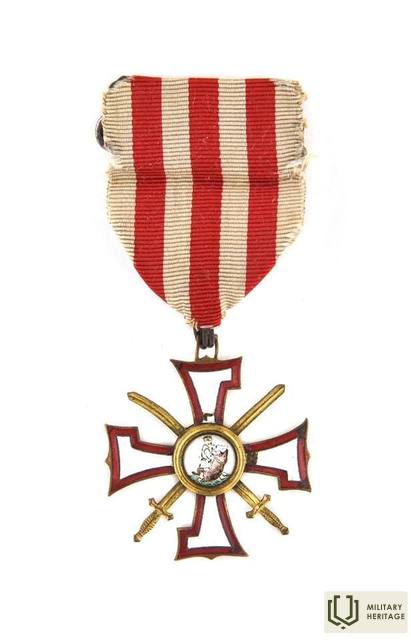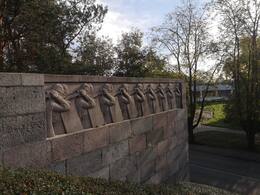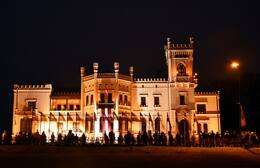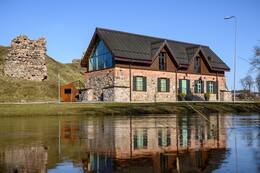7-oji Siguldos pėstininkų pulko bermontiada, Didžiosios kunigaikštienės Valijos Veščūnos apdovanojimas Lāčplės karo ordinu Alūksnėje.
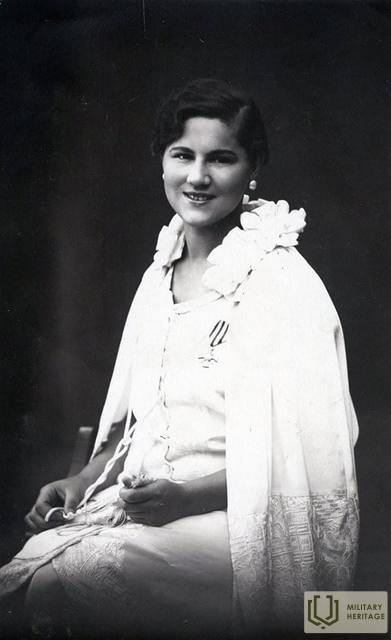
Po Latvijos nepriklausomybės karo didžioji seržantė Valija Veščuna už mūšius su bermontininkais prie Plānių namų 1919 m. lapkričio 19 d. buvo apdovanota Lačplėsio karo ordinu. Valija Veščuna buvo viena pirmųjų, perėjusių Lielupės upę, apšaudyta priešo.
„Aš jau mokėjau šaudyti, ir tai buvo 1919 metais Spilvės pievose. Tuo metu mūsų pulkų buvo padaugėję. Slėpėmės nuo priešo kulkų už šieno kupetų. Nežinau, ar kas nors buvo pataikytas, ar ne, bet tai ne svarbiausia. Net mintis, kad gali būti sužeistas Latvijos kareivis, buvo per sunki mano širdžiai. Jau buvau matęs sužeistuosius, ir tai taip pat pažadino manyje neapykantą Bermontui ir jo niekšų gaujai. Nesąmoningas nepasitenkinimas dėl pavojingos egzistencijos, žinoma, egzistavo ir anksčiau, bet dabar jis buvo realizuotas konkrečia forma. Taip pat suvokiau nuolatinės Latvijos valstybės įkūrimo būtinybę ir svarbą. Bermontas ėjo pirma mūsų, viską plėšė, bet kiekvienas kareivis turėjo žmoną, vaikus ar tėvus, giminaičius namuose, kurie taip neteko nė kąsnio užkąsti. Bermontininkai, atvykę į svetimą žemę, jautėsi atsakingi tik už savo egzistenciją. Ir pilvas priekyje. Mes buvome atsakingi už tolesnį savo tėvynės ir žmonių egzistavimą, už šio mažo žemės lopinėlio ateitį. Taip, mes juos visus vijosimės...“ kelias į Akmenę. Mes tiesiog neleidome sau patikėti, kad galime pralaimėti, todėl ir laimėjome.(..)
Mūsų 7-asis Siguldos pėstininkų pulkas buvo dislokuotas netoli Alūksnės. Pati ceremonija (Lačplėsio karo ordino įteikimas) vyko maždaug taip. Kariuomenė buvo išrikiuota aikštėje, ordiną įteikė Latvijos prezidentas Čakstė. Buvau pakviestas į Alūksnės pilį, kur vyko šventiniai pietūs. Po to pro Alūksnės pilies langus stebėjome kariuomenės paradą. Prisimenu tik kelis, kurie buvo su manimi – pulkininką Frickausą, jo žmoną.“
LNVM virtuali paroda „Lāčplės karo ordino kavalierius – Valerija Valija Veščuna-Jansone“ https://www.youtube.com/watch?v=ZtOtskNlhZQ
Valijos Valerijos Veščuno-Jansones prisiminimai. // Ralfas Vilandsas. Jai buvo šešiolika. Jūrmala, 1989 03 30, Nr.13.
Alūksnės muziejus
LNVM virtuali paroda „Lāčplėsio karo ordino kavalierius – Valerija Valija Veščuna-Jansone“ http://lnvm.lv/?p=12079
https://www.la.lv/skukis-kas-nebijas-naves
Susijusios vietos
Sudrabkalninio kalnas – memorialas kovai su Bermonto armija
Įsikūręs Rygoje, Pārdaugavoje, Sloko ir Kurzemes prospektų sankirtoje.
1919 m. lapkričio pradžioje, per Latvijos nepriklausomybės karus, Pardaugavoje vyko gatvių mūšiai tarp Latvijos armijos ir Bermonto kariuomenės. Lemiamas puolimas prieš Bermonto armiją įvyko šioje vietovėje. 1937 m. Sudrabkalninyje pagal Kārlio Zālės projektą buvo atidengtas paminklas, pagerbiantis žuvusius 6-ojo Rygos pėstininkų pulko karius ir pabrėžiantis jų karines savybes.
Sukurta kaip memorialinė siena – simbolinis įtvirtinimas, kurio vartuose pavaizduotas liūtas, blokuojantis kelią priešo puolimui. Pastatyta iš Daugavgryvos tvirtovės gynybinio pylimo akmeninių blokų ir iškalta iš Laisvės paminklo likusio granito. Memorialinės vietos kaina siekė beveik 35 000 latų. Palyginimui, už šią sumą buvo galima įsigyti 4 Latvijoje pagamintus „Ford - Shield V8 De Luxe“ automobilius.
Šiandien galite aplankyti vieną įspūdingiausių Nepriklausomybės kovų memorialų.
Alūksnės muziejus
Alūksnės muziejus įsikūręs nacionalinės reikšmės architektūros paminkle – neogotikinėje Alūksnės Naujojoje pilyje, pastatytoje XIX a. pabaigoje. Muziejuje veikia paroda „Totalitarinio režimo aukų memorialinis kambarys“, kurioje pasakojama apie Alūksnės savivaldybės gyventojų likimus Sibire ir Tolimuosiuose Rytuose, o laikotarpis nuo priešistorės iki šių dienų susitinka Alūksnės istorijos ekspozicijoje „Amžių šventė“. Joje yra atskiras skyrius, skirtas 7-ojo Siguldos pėstininkų pulko indėliui į kariuomenę, kultūrą ir visuomenės gyvenimą. 7-ojo Siguldos pėstininkų pulko formavimas prasidėjo 1919 m. birželio 20 d. Naukšėnų dvare. Iš pradžių iš Šiaurės Latvijos brigados rezervinio bataliono buvo suformuota 22 karininkų ir 1580 kareivių kovinė grupė, pavadinta Dankersų divizija. Ji buvo įtraukta į 3-iojo Jelgavos pulko 2-ąjį batalioną. Rugpjūčio 23 d., padidėjus kuopų skaičiui, jis tapo 7-ojo Siguldos pėstininkų pulko dalimi. Dalyvavęs mūšiuose prieš Bermontą, 1920 m. sausio 5 d. pulkas buvo perkeltas į Latgalos frontą kovoti su bolševikais. Pasirašius taikos sutartį su Sovietų Rusija, pulkas saugojo rytinę Latvijos sieną. Latvijos nepriklausomybės kare žuvo daugiau nei 200 pulko karių, o 85 buvo apdovanoti Lačplėšio karo ordinu. 1921 m. 7-asis Siguldos pėstininkų pulkas buvo dislokuotas Alūksnėje. Pulko štabas buvo įsikūręs Alūksnės naujojoje pilyje. Po Antrojo pasaulinio karo pilį perėmė sovietų saugumo institucijos. Nuo šeštojo dešimtmečio pabaigos pilyje buvo įsikūrusios įvairios kultūros įstaigos: Vykdomojo komiteto Kultūros ir kinematografijos skyrius, pionierių namai, biblioteka, kino teatras ir muziejus.
Laisvosios valstybės brangenybių namai
Nepriklausomos valstybės palikimą saugantys namai yra šalia Rėzeknės pilies griuvėsių.
Išskirtinėje ekspozicijoje pristatoma keli šimtai istorinių eksponatų iš Latvijos ir užsienio privačių kolekcijų, apimančių 1918–1940 m. laikotarpį, bei skirtingus Latgalos ir Rėzeknės istorijos puslapius. Supažindinama su Pirmosios nepriklausomos Latvijos valstybės karinių ir civilinių apdovanojimų istorija, įvairių valstybinių ir visuomeninių organizacijų veikla, vykusia nuo Latvijos nepriklausomybės karo iki Antrojo pasaulinio karo.
Tai didžiausia Latvijoje kolekcija, pristatanti nepriklausomos valstybės karinius ir civilinius apdovanojimus bei skiriamuosius ženklus.
Antrajame aukšte įrengta keičiamų parodų salė, kurioje bent kartą per metus surengiama nauja paroda. Lankytojai jau turėjo galimybę pamatyti išskirtinę porceliano dirbinių kolekciją, prabangius laikrodžius iš Prancūzijos ir įvairius Latgalos peizažus vaizduojančius paveikslus.




